
Mathematical ImageryMathematical artists create strong, stunning works in all media and explore the visualization of mathematics
2020 Mathematical Art Exhibition
The 2020 Mathematical Art Exhibition was held at the Joint Mathematical Meetings held in Denver, CO. Here on Mathematical Imagery is a selection of the works in various media, including recipients of the 2020 Mathematical Art Exhibition Awards: "Suspended Helical Stair," by Mark Donohue (California College of the Arts, San Francisco, CA), awarded Best textile, sculpture, or other medium; "A Unit Domino," by Douglas McKenna (Mathemaesthetics, Inc., Boulder, CO), awarded Best photograph, painting, or print; and "Computational Wings," by David Bachman (Pitzer College, Claremont, CA), Honorable Mention. The award "for aesthetically pleasing works that combine mathematics and art" was established in 2008 through an endowment provided to the American Mathematical Society by an anonymous donor who wishes to acknowledge those whose works demonstrate the beauty and elegance of mathematics expressed in a visual art form.

Inkjet print on canvas, 55 x 30 cm, 2019. The Apollonian gasket consists of nested circles, of sizes formulated by Fermat in 1637. The radii of all circles in the standard gasket are unit fractions, and I wanted to show that using spheres that stack up to the exact height of the big cylinder. The number of spheres in each stack is the reciprocal of the radius, also known as the curvature! Here we have three views: the nested circles shown on top as a single layer of sliced spheres, then as stacks of spheres in a cylinder, and on the bottom just nested cylinders. This is not the same as filling all the spaces with the largest possible spheres, although those radii would obey a similar formula. See an interactive 3D view. --- Dan Bach
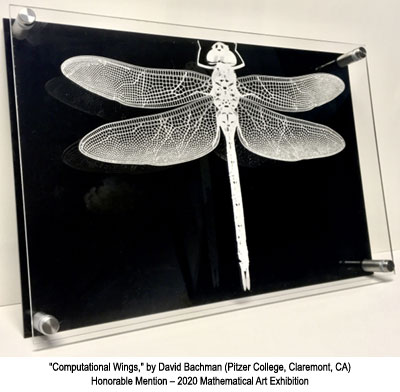
Honorable Mention – 2020 Mathematical Art Exhibition
Laser etched acrylic, 23 x 35 x 3 cm, 2019. The body of this dragonfly is taken from a photograph, while the wings were computationally generated. A variety of algorithms were used to create them. First, a set of points were randomly populated across each wing and moved by a circle packing algorithm, where the radius of each circle was inversely proportional to the distance from the body. Next, those points were used to create a Voronoi diagram. Main veins were located by a shortest walk algorithm through the edges of this diagram, and those veins were given a variable thickness according to the distance travelled as you traverse them outward from the body. --- David Bachman

Crepe de Chine fabric, glass seed beads, thread, 40 x 40 cm, 2019. Trefoil-knotted toroidal scarf and bracelet. The scarf is constructed with a small hole left in one seam so that, in addition to functioning as a scarf, the wearer can explore what happens when the knotted torus is inverted. Since its meridian and longitudinal loops swap roles when a torus is inverted, the inverted scarf becomes an unwearable torus with a knotted hole (see drawing upper left). The bead crochet bracelet pattern is one of the tessellated waves from the scarf fabric. The bracelet is worn by placing your hand through the central hole of the knot and rolling it on. The scarf can be worn several ways, but my favorite is likewise to put my head through the center, which creates a braid form of the knot with a flattering drape. --- Ellie Baker

Knitted wool yarns (Dream in Color Classy), 28 x 43 x 6 cm, 2019. The Petersen graph is the smallest snark and has genus one, meaning that it can be embedded in the torus, but not the plane, without edges crossing. The edges are properly four-colored, as an edge three-coloring is not possible. We show this embedding on an ordinary torus and also on a torus with a disc removed so that it can be instantiated as a blanket square. The Petersen graph is literally embedded in the ordinary torus via intarsia, whereas it is surface-crocheted as an embellishment on the toroidal blanket square. --- sarah-marie belcastro
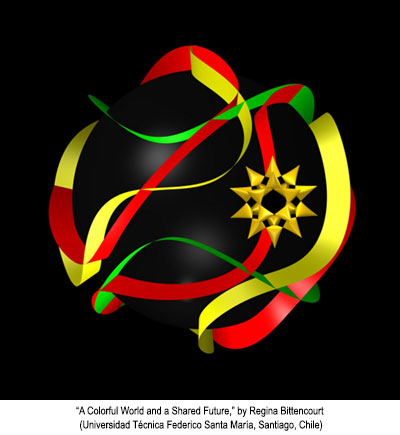
Giclée on museum canvas, 48 x 48 cm, 2018. Image rendered using 5 polynomial equations. Each one displays different algebraic surfaces: 3 of them are the ribbons that surround the sphere. And the star is a Barth Sextic surface. The polynomial equations are: $x^3+y^3+z^3+1-0.5a(x+y+z+1)^3=0$
$x^2+y^2+z^2-50=0$
$x^2-y^2-za=0$ and
$x^3y+y^3z+z^3x=0.$
The image represents our world on the infinite of the universe. Harmony in diversity, beauty, good fortune, wealth, fertility and hope, surround our world in colored ribbons. The beautiful star is our shared bright golden future. --- Regina Bittencourt
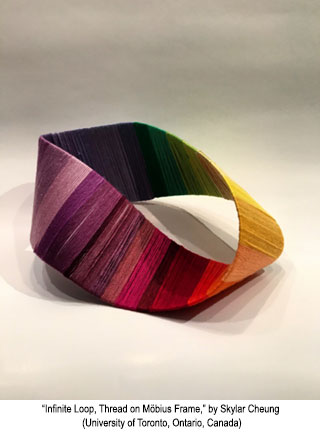
Thread on cardstock frame, 13 x 30 x 25 cm, 2019. One can obtain an orientable torus by deforming string wrapped around the non-orientable Möbius strip. Though the torus and the Möbius strip have the same fundamental groups, they are not homotopy equivalent (there is no continuous way to turn one surface into another). This work demonstrates a simple example of a broader topological question: what are the properties of a surface obtained by wrapping-string around a “parent” object and uniting the strands? Consider two objects A and B. Wrap string around their inner and outer surfaces, and glue the loops of the string together in order to get corresponding surfaces A* and B*. If you can pull and push (without tearing!) A* into B*, then A and B are homotopy equivalent. Can you prove it? --- Skylar Cheung

Mixed media ink on Dibond-Aluminium, 60 x 60 x 2 cm, 2019. Mathematicians and statisticians use graphs to study and understand randomness. However, graphs are seldom explored in the visual arts. They can be inspirational, fun, and a good conversation starter. This iteration of the shortest route problem was composed after Dr. Porteus textbook on stochastic processes (2002). The nodes on the central grid are replaced by numbers, 1 on the left, 16 on the right, 7 on top and 10 at the bottom. Using a recursive method, the shortest distance from node 1 to node 16 is 15, and the shortest route is along nodes l-3-6-10-13-15-16. I slightly enhanced the key position 15 to guide the viewer's eye toward the best possible solution. --- Jean Constant

Best textile, sculpture, or other medium – 2020 Mathematical Art Exhibition
String, plywood, 45 x 23 x 23 cm, 2018. A unique cable system to suspend a stair was developed in collaboration with a leading structural engineer. The suspended cables form a double helicoid nested within an ascending spiral hyperboloid to create the necessary points of support for the gravity loads and lateral bracing for the seismic loads. Each concrete stair tread was designed as an independent element that is strung together with the stairs above and below it to form a single spiral stair when the steel cables that run through them are post tensioned. The entire stair tread and suspension cable system can be understood as a play of ruled surfaces with each part related to the other through their shared geometric lineage. --- Mark Donohue
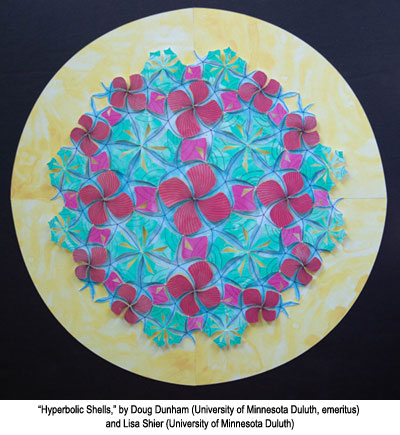
Computer plotted and cut paper, 40 x 40 cm, 2019. This pattern is inspired by M.C Escher's Regular Division Drawing 42, which is mathematically interesting since the apparent 4-fold rotation centers of scallop shells only have 2-fold rotational symmetry, and there are two kinds of 4-fold rotations at the meeting points of conchs. So Escher's pattern has symmetry group p4, or 442 in orbifold notation. Our hyperbolic version preserves the 2-fold scallop meeting points and has two kinds of 5-fold conch rotation centers, yielding the symmetry group 552 in orbifold notation. We placed spacers under the conchs, scallops, and snails in order to produce a 3D-like effect. We also used different colors than Escher. By experimentation, we chose paper colors that were fairly scale-invariant. --- Doug Dunham and Lisa Shier
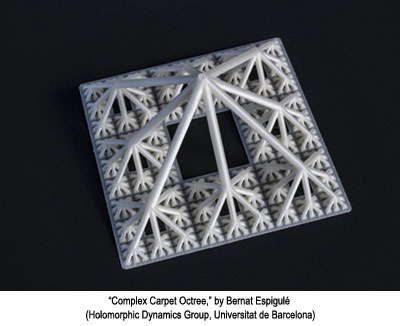
PLA plastic UM3, 5 x 10 x 10 cm, 2019. This mathematical sculpture, designed in Mathematica and 3D printed at ICERM's Ultimaker 3, illustrates how the Sierpinski carpet fractal is the limiting set of an octree (each node has exactly eight children). The Sierpinski carpet is a "universal plane continuum", any compact plane curve can be homeomorphically manipulated to fit inside the carpet. Robert L. Devaney has popularized its use as a toy model to study the topology of Julia sets for families of rational maps. The Sierpinski carpet has been also extensively used as a fractal antenna for mobile phones. The 3D tree version designed by the author can be assembled in six copies joint by their initial node to make the external faces of a Menger sponge. --- Bernat Espigulé

Digital print on aluminum, 51 x 61 cm, 2019. This sampler shows nine ways to create polyhedral symmetry from bands placed in space. The top row shows tetrahedral shapes "woven" from three, twelve, and four bands, with the middle one not woven at all. The middle row holds configurations with octahedral symmetry, the two on the right showing two distinct ways to weave a cube with six bands: bands with D2 versus C4 symmetry. The bottom row holds icosahedral complexes. The lower left shows the 5-coloring of an icosahedral shape, made from five 6-banded tetrahedra. A paper (with SCU student Wilder Boyden) on this method has been submitted to the Journal of Mathematics and the Arts. The chain mail background applies the same method, using a wallpaper group instead of a polyhedral one. --- Frank A. Farris

Ceramics, 23 x 23 x 23 cm, 2018. Mathematical structure is evident throughout the natural world. My work explores the mathematics of symmetry, fractals, tessellations and more, blending it with plant and animal forms as well as inorganic forms found in nature. This synthesis allows me to create innovative prints and sculptures that derive their beauty from a combination of complexity and underlying order. This ceramic sculpture is inspired by mineral skeletons of radiolarians, a type of plankton. The geometric basis is a Goldberg polyhedron with octahedral symmetry. --- Robert Fathauer
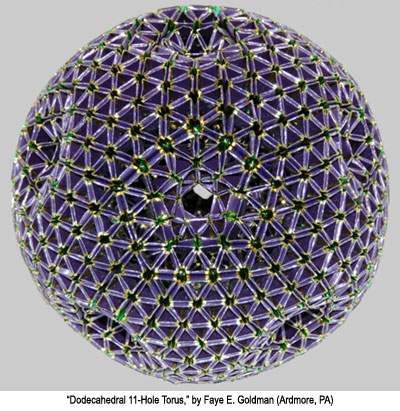
Polypropylene ribbon, 17 x 17 x 17 cm, 2019. I was blown away with David Honda's Dodecahedal 11 Hole Torus at the JMM 2018 Exhibition of Mathematical Art in San Diego. I wanted to try to make one of my own in order to understand the structure. The finished structure is based on a dodecahedron. Each pentagonal face has a funnel pointing into the center. These 12 funnels meet inside in another dodecahedral structure. Only triangles are used in the entire model. Most of the vertices are of degree 6 (6 triangles meet at a point). There are 120 vertices of degree 7. Half of these are barely visible. The other half are buried inside. They force the negative curvature of the model. --- Faye E. Goldman

Merino/cotton yarn, wooden dowels, 27 x 21 cm, 2019. An outgrowth of current research by the artist and Carolyn Yackel, this mosaic-knitted scroll shows all seven frieze symmetries. Mosaic knitting, a popular type of two-color knitting, imposes unusual constraints on color placement that limit the types of symmetry attainable in the form. All of the frieze groups are compatible with these constraints. In older forms of two-color knitting, extended runs of a single color create long yarn floats across the back of the fabric, making the wrong side unruly and prone to snagging and the right side hard to keep neat and even. The mosaic technique makes this piece entirely free of floats. The hand-dyed yarn comes from the yarn maker's shop, Makeri 14 in Stockholm. --- Susan Goldstine
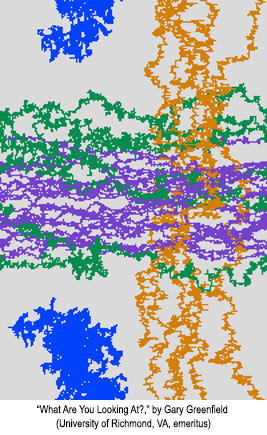
Digital print, 23 x 15 cm, 2019. On a 200 x 300 toroidal grid each cell has four rotors that advance independently. The rotors have 8, 5, 4 and 4 segments numbered 1-8, 1-5, 1-4 and 1-4. After rotor initialization, four cells are selected to receive "painting objects" that paint in different colors and, respectively, have finite sequences over the alphabet (R)ight, (D)own, (L)eft, (U)p of lengths 8, 5, 4 and 4. At each time step, cells with objects assume the color of the object, use the value of the appropriate rotor as an index for deciding where to send the object, and then advance the appropriate rotor. This "rotor router" model is used to deterministically simulate random walks. We use a genetic algorithm to find placements and sequences that maximize connectivity. --- Gary Greenfield

20 lb. copy paper, 17 x 17 x 17 cm, 1993. This modular origami polyhedron is a variation of the Platonic Solid, dodecahedron. It is made from 90 modules folded from squares. There are two types of modules, 60 that make up the 12 pentagonal cones, and 30 that each connect two cones along an edge of the dodecahedron. The modules are very simple. The cones are made of modules that are half of the traditional paper cup, linked together. The connectors are kite bases on opposite corners of a square. No adhesive is used to hold the model together. Many other polyhedra can be made with this system by varying the number of cones and the polygon that is the cone's rim and folding the appropriate number of connectors. The central angle of the modules is 45 degrees. --- Rona Gurkewitz and Bennett Arnstein

Metal photo print, 18 x 28 cm, 2019. Flow visualization embodies both art and science, which are similar in that they both thrive on deep seeing, on expanded perception and attention, which can be gained through simple experience. What happens in the human heart? At a prosaic level, we can measure the velocity of the blood with 4DMRI technology. The velocity field in the right ventricle of a normal subject is shown as white velocity vectors; the larger the white pencil shapes, the faster the flow at that location. Vorticity, computed as the curl of the velocity field, is represented by the colored arrows; the arrow shaft is the local axis of spin at that location. We see flow penetrating deep into ventricle, during diastole, as the ventricle fills, preparing to pump blood to the lungs. Vorticity surrounds the flow, generated by shear at the walls of the tricuspid leaflets and other structures in the ventricle. Vortex rings are formed and washed away with each beat. --- Jean Hertzberg
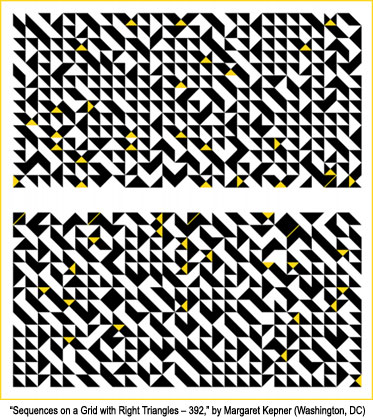
Archival inkjet print, 50 x 50 cm, 2019. In this work, several integer sequences (between 1 and 392) are displayed on a rectangular grid using isosceles right triangle shapes. In the top rectangle, black triangles are oriented in four ways depending on whether they represent prime, happy, or triangular numbers, or none of these. When an integer belongs to two sequences, the corresponding triangles are superimposed and their intersection region is colored yellow. (There are no three-way overlaps for these sequences.) The lower rectangle follows the same logic for three different integer sequences: the lucky, Harshad, and generalized pentagonal numbers. The number “1” appears at the lower-right corner of the top rectangle and at the upper-left corner of the lower one. --- Margaret Kepner
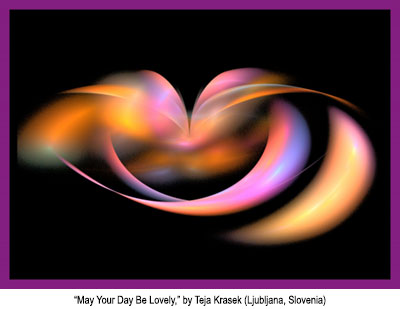
Digital print, 21 x 30 cm, 2019. In the wonderful, mysterious, and complex realms of chaos and strange attractors a seeker can find delicate, beautiful, and sometimes even very heartfelt phenomena. --- Teja Krasek

Paper, 20 x 46 x 16 cm, 2019. “Wandering Quadrilaterals” came out of Twitter musings between math educators. We wondered about the nature of the foldability of tessellating patterns. I tried out some. These particular quadrilaterals unexpectedly, and delightfully, insisted on curling, and then they went on to spiral even as their edges stayed rigid and straight. It was a productive struggle to follow the prompts of the angles to make folds that would show the tiling as well as support the spiraling. The final surprise is that it compresses into a hexagon-like packet. This iteration of wandering quadrilaterals is larger than my original ones, thus creating fresh problems to solve. Nods to my math community, for nudging this process along, and for keeping math playful. --- Paula Krieg
![Garden (rhombus-9 [5,1,1,1,1])](https://www.ams.org/images/jmm2020-mai.jpg)
Digital inkjet print, 20 x 20 cm, 2019. My recent work explores “shape-partitions” of a rhombus, each partition a distinct combination of component shapes that envelop between 1 and 9 points within the rhombus. This composition is the complete set of 21 shape-partitions belonging to the partition group [5,1,1,1,1]. Nine forms clustered in the center are symmetric: one form with 2 axes; six forms with 1 axis (four with a shorter axis, two with a longer axis); two forms with rotation-only symmetry. The remaining twelve forms along the edges of the group are asymmetric. Additionally, some forms are related as rearrangements of the same component shapes (for example, the two forms with U-shapes at the top). There are six such pairs and one trio (with trapezoid shapes, lower left), each positioned as near as possible to their companions. --- James Mai
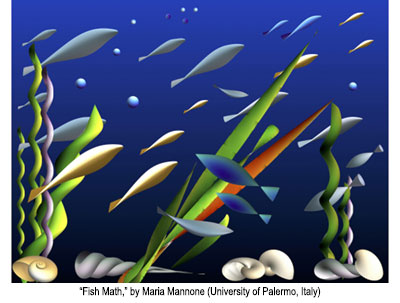
Graphics, 30 x 23 cm, 2019. In "Fish Math" I used abstract shapes obtained as graphs of parametric equations, as well as revolution solids, to imitate an oceanic landscape, with fish, algae, and shells. Mathematics is alive as an ocean, and natural forms can be perfect and inspiring as math! The image, inspired by the ocean, contains graphs of parametric equations and revolution solids implemented with Mathematica software, e.g., for some fish: RevolutionPlot3D[Sin[t]/2, {t, -Pi/4, Pi}, RevolutionAxis -> "X", Axes -> None, Mesh -> False, Boxed -> False, Background -> Black, ColorFunction -> (ColorData["Aquamarine"][#4] &)] And, for some algae: ParametricPlot3D[{Cos[u] Sin[v], Sin[u] Sin[v], u^2}, {u, 0, 2 Pi}, {v, 0, 10 Pi}, Mesh -> None, Axes -> None, Boxed -> False,
ColorFunction -> (ColorData["AvocadoColors"][#1] &)] Colors of each single figure have also been defined within Mathematica coding. The figures have then been put together within a Keynote document with a gradient color background. --- Maria Mannone
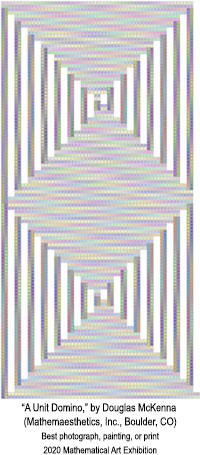
Best photograph, painting, or print - 2020 Mathematical Art Exhibition
Giclée print, 106 x 66 cm, 2015. This piece is based upon an artist-discovered "half-domino" space-filling curve. The drawing comprises some half-million connected line segments, arranged in two perfectly recursive levels of double-spiral pairs, slowly changing color, in a single, over-one-mile-long self-avoiding path from lower left to lower right (the lower right square that sticks out is an integral part of its self-negative structure). The limiting curve covers a self-similar gasket tile with an infinitely long, almost-everywhere linear border. With an upside-down copy of itself, two such gaskets of unit area exactly cover a 1x2 domino, without overlap. The artist's app/eBook 'Hilbert Curves' for iPad/iPhone explains how he discovered these beautiful constructions. --- Douglas McKenna
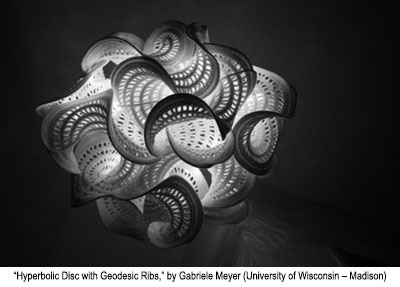
Yarn and plastic line, 38 x 58 x 56 cm, 2019. This is a hyperbolic disc that was crocheted using triples and chain stitches, thereby generating large holes. For minimal stabilization, every second row was singles around plastic line. Still the surface was very floppy and did not hold its shape. I crocheted a rim of singles around the perimeter and then added ribs reinforced with plastic line. These ribs follow geodesics: a vertical line from the top to the bottom of the disc and then several along circles with centers along the north-south axis and perpendicular to the perimeter of the disc. This made the surface hold its shape. For lighting, I threaded a string of fairy lights through the crochet. --- Gabriele Meyer
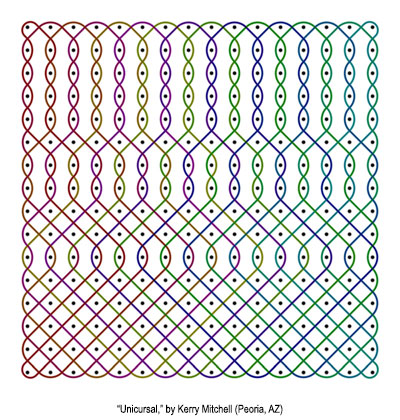
Digital print on aluminum panel, 40 x 40 cm, 2018. My inspiration for this image came from studies of kolam and sona drawings, as done in Asian and African cultures, respectively. Both involve drawings a loop around a grid of points, such that the continuous path goes once around each dot and returns to its beginning. In this case, the grid is 16 x 16 dots and the loop were constructed to exhibit symmetry in each column of dots. The hue of the curve's color varies along the path, to help the viewer keep track of it, and to align with the cyclical concepts behind this type of art. --- Kerry Mitchell
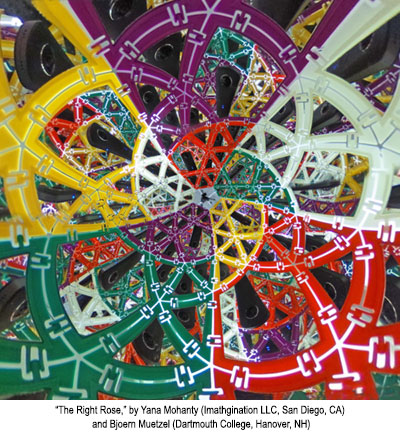
Photography, 30 x 30 cm, 2019. The snub dodecahedron is one of two chiral Archimedean solids. At 92 faces, it is a fairly good approximation of a sphere, but its chirality is not easy to see. This made the snub dodecahedron an ideal subject for a photograph by a spherical camera. An unusual presentation of the snub dodecahedron, "The Right Rose" resulted from placing the spherical camera close to the center of the solid, and stereographically projecting from the "pole" opposite to where the camera is inserted. The edges of the snub dodecahedron are roughly mapped to arcs of circles on the plane, which look like petals tangent to the boundary of the image. See . Unlike the medieval rose windows, this rose is right--in the chiral sense! --- Yana Mohanty and Bjoern Muetzel
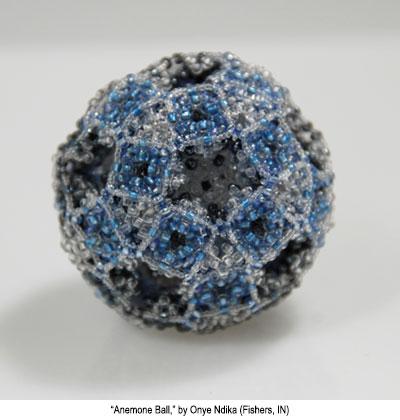
Glass seed beads: sizes 6-20; 6 lb monofilament, 4 x 4 x 4 cm, 2019. This orb was an experiment in hyper-layering of seed beads using netting, right-angle weave, peyote stitch, square stitch and triangle weave. At the deepest center of the sphere, the construction stems from the icosahedron. I drew inspiration from the rhombic triacontahedron. However, the finishing step created a fascinating boundary for the gunmetal (dark grey) and sapphire blue protrusions--reminding me of sea anemone--and resulting in a small rhombicosidodecahedron. --- Onye Ndika
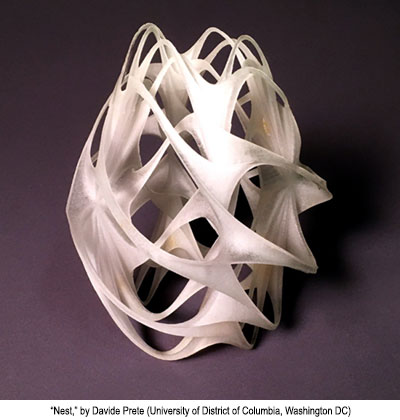
3D printed resin, 12 x 10 x 10 cm, 2019. The sculpture Nest is modeled from a toroidal warping of a truncated Scherk minimal surface. The frosted 3D printed resin gives the opportunity to visualize how the shape is bending and twisting giving an interesting change in tonal values. --- David Prete

3D print, 20 x 20 x 20 cm, 2019. This artwork depicts a small sample of the infinite number of parabolas that pass through three points. It is based on a recent paper ("All Parabolas through Three Non-collinear Points" by Huddy and Jones; Mathematical Gazette 102, July 2018, 203-209). Three control points are rotated around the z-axis resulting in three rings. A parabola exists with an axis of symmetry at every angle in the range [0,Pi] except the three where a pair of the control points are co-linear. The parabola with an axis of symmetry at an angle theta is associated with a parabola in the sculpture in the xz-plane rotated around the z-axis by an angle twice theta. --- David Reimann
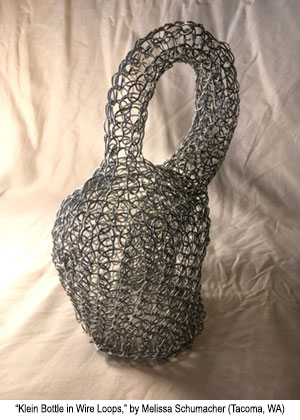
Galvanized steel wire, 17 x 13 x 9 cm, 2019. I am neither a professional mathematician nor a professional artist, but I love to combine math and art. In most depictions of Klein bottles, the surface can't intersect itself, but here it can because the "surface" is made of loops that can be woven through each other. I was inspired to make a Klein bottle using wire loops when I visited Katherine Hogan's studio and saw her demonstration of the basic technique. --- Melissa Schumacher
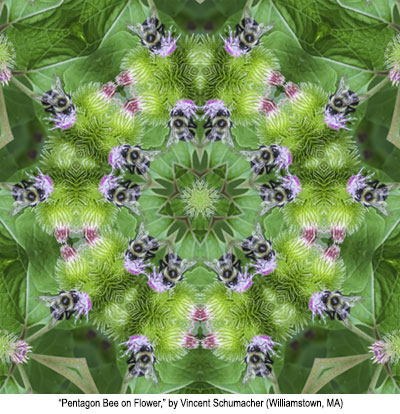
Photograph, 50 x 50 cm, 2019. The challenge was to fill a tessellated space with a photographic image so that the edge of each tile continued seamlessly into the edge of every tile it touched. This image began as a pentagon-cropped bee on a flower. The pentagon was mirrored and rotated along an edge until 10 pentagonal images circled back to line up seamlessly with the original. To fill the interior of this circle, a 72-72-36 degree triangle was cut from the original pentagon and mirrored inward. This created 10 triangles whose center angles added to 360 degrees. New triangular cuts were reflected outward to expand the image so the photo could be cropped to a square. The final seamless image creates new sets of visual patterns not found in the tessellated space alone. --- Vincent Schumacher

ABS, 3D-print, 22 x 22 x 10 cm, 2019. The basic approach to creating multi-level "Space-Shells" introduced in the spherical sculpture shown first is quite versatile and can readily be applied to toroidal structures as well. The quadrilateral tiling used on the torus is its own dual; thus similar shells can readily be nested. However, for any spherical "Space-Shells" just the two dual ribbon meshes needed to be designed, which then can be instantiated multiple times using simple uniform scaling. In a toroidal structure every nested shell has a different geometry and needs to be designed individually. The "Ring-World" model took 76 hours to print on a Stratasys Dimension 1200 machine and 48 hours in a lie bath to remove the internal support. --- Carlo Séquin
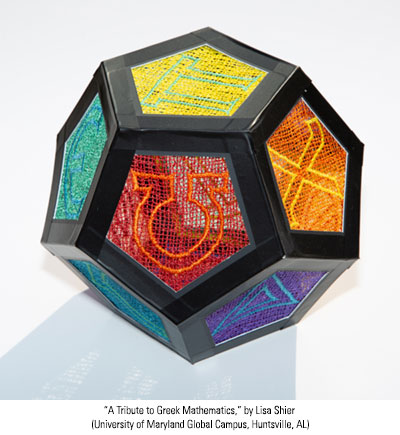
Free standing lace in a posterboard frame, 15 x 15 x 15 cm, 2019. This work began as an experiment in using free standing lace to create a three dimensional artwork. The lace is created with an embroidery sewing machine so the pieces are necessarily flat. Polyhedra have flat faces, so this was my first choice. The dodecahedron is a Platonic solid, reminding of the many contributions of the ancient Greeks to mathematics. It has 12 faces, half of the 24 letters of the Greek alphabet. I chose to decorate the faces with Greek letters of special significance in mathematics. Six (half of 12) colors are used. No two faces with the same background or letter colors touch. The letters are one color to the right or left of the background color on the color wheel for 12 combinations. --- Lisa Shier
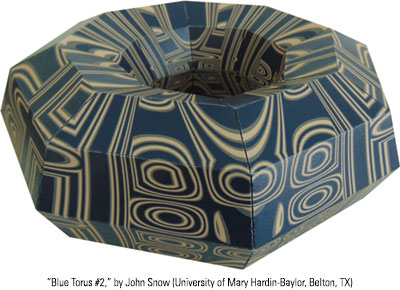
Digital print on paper, 8 x 22 x 22 cm, 2019. A random binary operation on [-1,1] is generated using functions from precalculus. Then parametric equations are used to map this binary operation to a function on the surface of a torus. Values of this function are interpreted as colors to paint the torus, and the result is projected onto this 64-sided polyhedral approximation of a torus. --- John Snow

Acrylic on canvas, 30 x 30 x 30 cm, 2010. I have spent over 50 years exploring six-point perspective on the sphere in order to capture up down and all-around environments. The six points are the six vertices of the octahedron drawn on the sphere. Two worlds are in the same place at the same time. This is a clear acrylic sphere with images on the inside and the outside. It is painted with acrylics. All of the painting is done on the outside of the sphere. The stairway is painted first on the outside using a six-point perspective system. It has to be designed so you can see inside the sphere so, one side of the stairway is left clear. Many coats of gesso are then painted over the stairs so they only show on the inside. Within the patterns given on the outside a new world is painted on top of the gesso. Trees, cliffs and cubical structures are painted on the outside white patterns. Two worlds are on the same surface but one is concave and the other is convex. --- Dick A. Termes
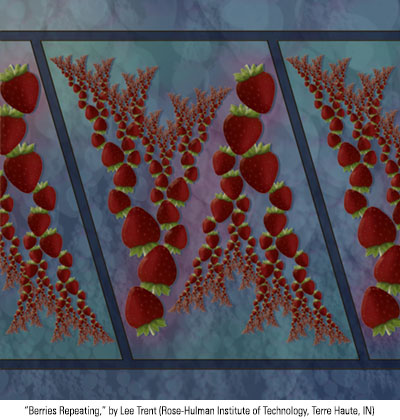
Digital art, 30 x 30 cm, 2019. Intentionally ordered and planned fractals are nice, but there's something organic about just translating, rotating, and scaling an image, and repeating and repeating and repeating. Sometimes what you get is uninteresting because it's too plain or too chaotic, but other times, that's not the case. I've made a lot of fractals from repetition of small images, but this is one of my favorites. --- Lee Trent
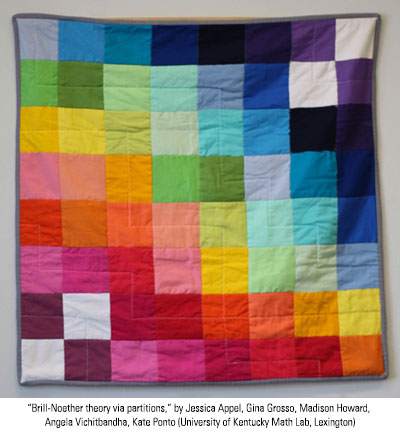
Textiles, Quilting, 63 x 63 x 1 cm, 2018. Brill-Noether theory is the study of line bundles on algebraic curves. A central problem is to determine how many curves possess line bundles with given invariants. Pflueger showed that this problem can be reduced to the study tableaux. This quilt by Jessica Appel, Gina Grosso, Madison Howard, Angela Vichitbandha, Kate Ponto represents a tableau in which the numbers are replaced with colors, in rainbow order. It demonstrates that the space of genus g curves possessing a line bundle of rank 7 and degree g-1 has the expected dimension, for g at least 34. This tableau was found using code developed by Kristopher Andrew, Jessica Appel, Madison Howard, Elijah Jackson, Jackson Morris, and Dave Jensen. Photo courtesy of Katie Davenport. --- University of Kentucky Math Lab
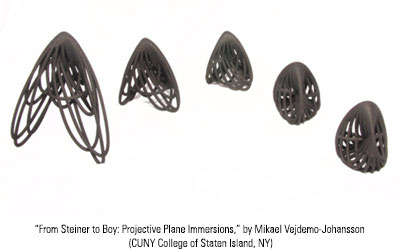
3d-printed nylon, 7 x 30 x 6 cm, 2019. The advent of accessible automated tools — 3d printers, laser cutters, CNC-controlled mills, vinyl cutters, etc — opens up a number of new approaches to art: especially algorithmic and mathematical art works. Morin and Apéry (1987) gave a family of parametrized surfaces that interpolate between Steiner's Roman Surface and Boy's Surface. All the surfaces in the parametrization are immersions of the real projective plane into 3-dimensional Euclidean space, but the Roman surface has a high degree singularity at the center which Boy's surface avoids. Here, we reify the family by giving the two extremes as well as the 25%, 50% and 75% intermediate steps between the surfaces. By representing them as wire frames, the parametrization itself can be traced out and studied tangibly. --- Mikael Vejdemo-Johansson
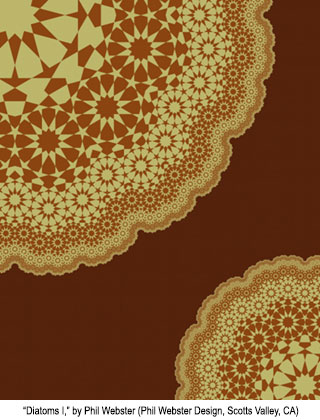
Digital print, 50 x 40 cm, 2013. My previous Fractal Islamic Patterns had either 8- or 10-fold symmetry. Instead, this piece has global and local 12-fold rotational symmetry. In the full pattern, rosette centers occupy the nodes of 12 fractal quaternary trees emanating from the center of the pattern and then pruned at the 12 sector boundaries. Six levels of a theoretically infinite fractal pattern are shown. This piece varies from previous works in two other ways. Due to how successive layers are connected, a two-coloring naturally creates alternation between the dark and light colors at each level. Also, instead of one pattern in its entirety, parts of two copies at different scales are shown. The result reminded me of creatures on a microscope slide, hence the title. --- Phil Webster
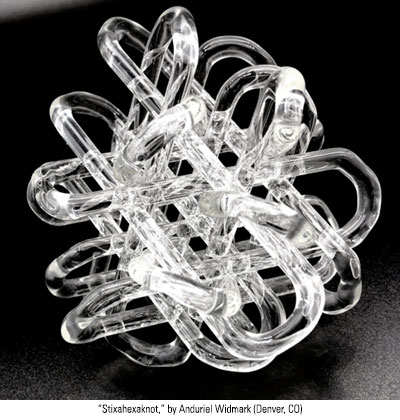
Flame worked borosilicate glass, 11 x 11 x 11 cm, 2019. Stixahexaknot is a small glass knot based on a periodic non-intersecting arrangement of cylinders known as hexastix. The ends of rods were welded together using tetrahedral symmetry to create a knot. Using transparent glass allows light to dance around and illuminate the interior geometry in a fascinating way. --- Anduriel Widmark
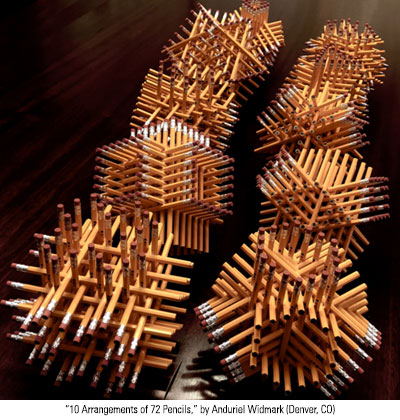
Wood pencils, 20 x 40 x 100 cm, 2019. "10 different arrangements of 72 pencils" explores ways to organizing non-intersecting arrangements of cylinder packings. "72 pencils" is a sculpture made of pencils originally produced by George Hart, that has become a popular form for math enthusiasts to reproduce. This Hexastix structure uses economic materials and provides a challenging construction, making it an accessible and satisfying structure to make. 720 pencils are used to show alternative subgroups and patterns, creating 10 congruent cylinder packings of 72 pencils. Interesting combinations are used to highlight a variety of geometric problems. Building these sculptures is a fun way to get creative and use mathematics to explore symmetry and build spatial intuition. --- Anduriel Widmark
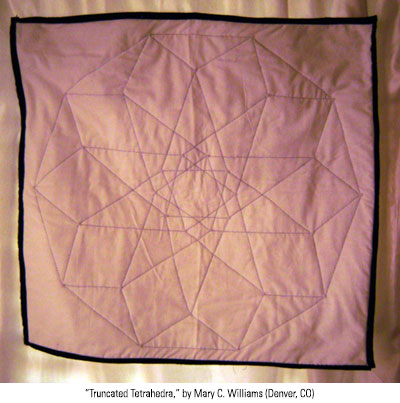
Hand quilted on cotton, 60 x 60 cm, 2017. --- Mary C. Williams

Lavender Granite Paper 56 x 80 cm, folded 26 x 32 x 2 cm, 2019. As an aspiring mathematician, I tinker with origami as a method to explore my interests in mathematics. This is the most complex piece I’ve created to date, bridging the gap between classic 2D tessellations and the tangible 3D world. The title of the piece, pyramidal Hexagonal mosaic, has an embedded meaning. Taking hexagonal to mean 6, it can be abbreviated as p6m, and this tessellation has type p6m. Rabbit-ear triangle sink-folds in the well-known Stacked Triangles tessellation were my inspiration for this piece. I had never seen a tessellation that used this unique fold before and I wanted to create something that incorporated this with other techniques, as well as exploring the third dimension. I accomplished this by drawing inspiration from the classic origami balloon, and applying it to the rabbit-ear triangle sink-folds to pop them up into the small square pyramids present on the surface. --- Aaron Yu



